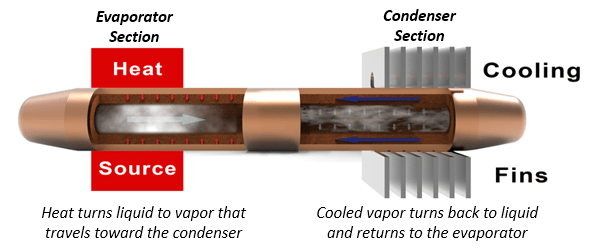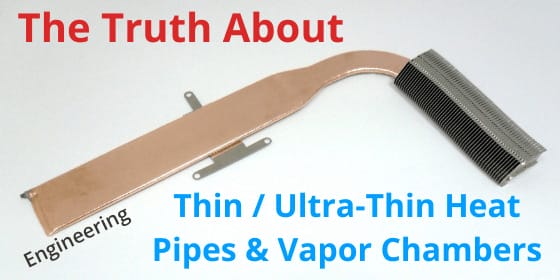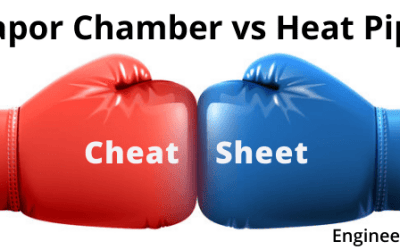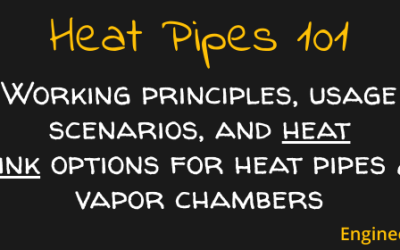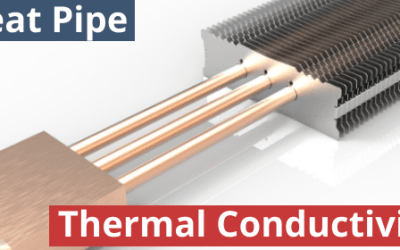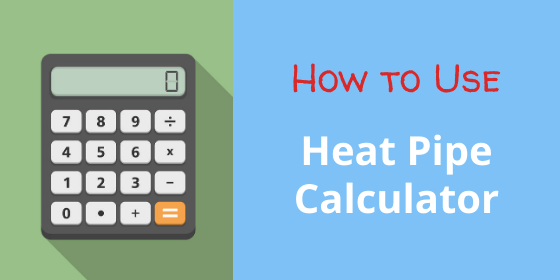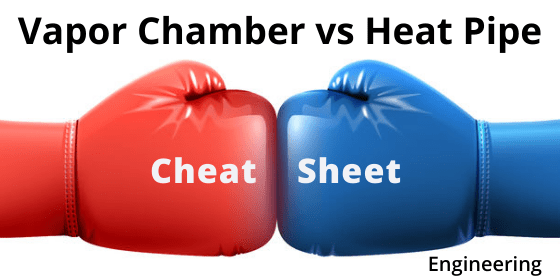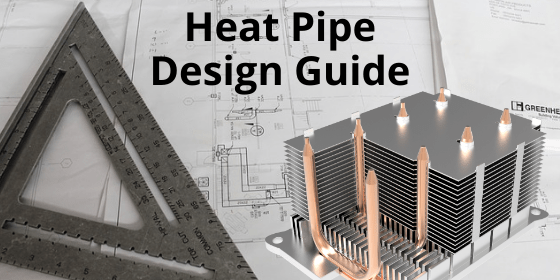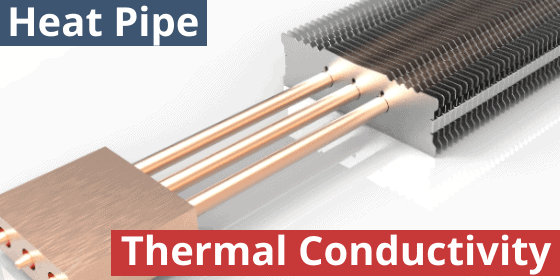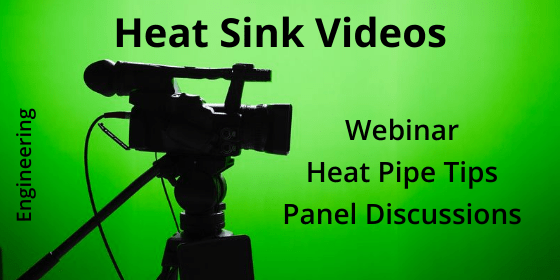Heat Pipe
A heat pipe is a passive two-phase heat transfer device designed to boost the performance of standard heat sinks through an evaporation and condensation cycle of a working fluid enclosed within a vacuum sealed enclosure. They are commonly used when heat from an electronic component (semiconductor) cannot be moved or spread efficiently enough by a standard finned aluminum or copper heat sink. Their high thermal conductivity, ease with which they can be bent & shaped, and exceedingly long operational life make heat pipes an ideal choice when heat needs to be moved or spread efficiently to the condenser area of the heat sink (usually a fin stack).
Topics:
- Heat Pipe Technology
- Heat Pipe Working Principles
- Types of Heat Pipes
- When to Use Heat Pipes
- Heat Pipe Performance
- Heat Pipe Bending & Flattening
Heat Pipe Technology
To understand heat pipe technology, it is important to define each component of the device: enclosure material, wick structure, and working fluid.
Heat Pipe Enclosure / Envelope Material
The heat pipe enclosure is a vacuum-sealed vessel (tube or envelope) housing a working fluid that carries heat away from the semiconductor when in vapor form and a wick structure that transports condensed vapor (liquid) back to the heat source. The most used enclosure material is copper followed by aluminum, but stainless steel and titanium are also used depending on the application and long-term compatibility of the enclosure material with the wick structure and working fluid. Thicker walls can be used to enhance the structural integrity of the device, while thinner walls may be more suitable for space-constrained applications.
Heat Pipe Wick Structure
Heat pipe wicks are capillary structures along the inner wall(s) of the device used to transport working fluid from the condenser area of the heat sink back to the heat source while keeping it separated from the vapor traveling in the other direction. Wick structures vary in their ability a) to handle higher power density applications and b) to move liquid against gravity as when the heated area of the heat pipe (evaporator) is above the cooler area (condenser).
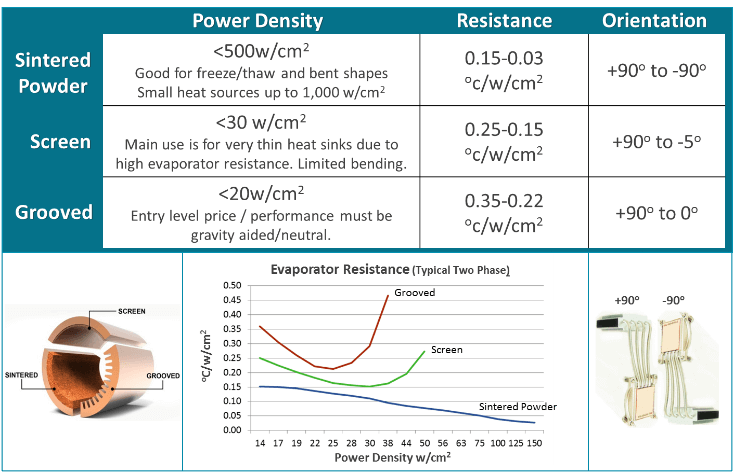
Heat Pipe Wick Types, Heat Flux, & Thermal Resistance
Sintered Wick – produced by lining the walls of the heat pipe with a powered metal, usually copper, and baking it at high temperatures to fuse the particles to one another and to the device wall – the same process used to make automotive brake pads. Because they can handle high heat flux and work very well against gravity, sintered copper heat pipes allow for the most design flexibility making them the most widely used heat pipes for cooling electronics.
Screen / Mesh or Braided Wick – screen mesh with perpendicular metal strands, like a screen door, or braided copper threads running in the same direction, are another type of heat pipe wick material. They are generally used to make heat pipes as thin as possible while still allowing the device to function against gravity at shallow angles. Mesh and braided wick heat pipes are less expensive than their sintered wick counterpart but are more limited when semiconductor heat flux increases.
Grooved Wick – the primary benefit of grooved heat pipes is the low price as the wick structure is formed as part of the heat pipe extrusion process. These devices can only function correctly in gravity neutral or gravity aided applications when the condenser is level with or above the evaporator.
Working Fluids Used in Heat Pipes
When in vapor form, the working fluid is what allows heat pipes to achieve much higher thermal conductivities (lower thermal resistance) than solid copper or aluminum. The fluid choice depends mainly on the temperature range in which the device is designed to operate, but also the orientation of the heat pipe, and toxicity/flammability of the liquid.
The figure of merit (FOM), the second column in the table below, is a way to compare how well different liquids perform as working fluids in heat pipes. It’s a score that tells engineers which liquid is better at moving heat around – the higher the figure the better. To calculate the FOM, divide the effective thermal conductivity of the working fluid by its vapor pressure at the operating temperature.

Common Heat Pipe Working Fluids
The next variable of interest is the surface tension of the working fluid. This is an important factor in determining the capillary action that drives the flow of the working fluid in a heat pipe. The surface tension of the working fluid interacts with the wick structure inside the heat pipe to provide the capillary force needed to move the liquid from the condenser to the evaporator. A higher surface tension means a stronger capillary force and a more efficient heat pipe.
Once the correct working fluid is selected, a compatible enclosure is selected. Both water and methanol heat pipes are compatible with copper enclosures, while ammonia and acetone heat pipes mainly use aluminum. Mixing incompatible materials shortens the life of the heat pipes.
Celsia optimizes enclosure wall thickness, wick properties such as thickness and porosity, and fluid-loading for each application. Throughout the production process, each heat pipe undergoes rigorous testing to ensure optimal performance and reliability. Prior to integration into the heat sink, every heat pipe is subjected to burn-in and helium testing to detect any leaks and confirm thermal performance. Additionally, every completed heat pipe assembly is thoroughly tested against dimensional and thermal requirements. Contact us with your application-specific requirements.
Heat Pipe Working Principles
Thermal Conductivity – Heat pipe thermal conductivity varies in practical terms between 1,500 to 60,000 W/(mK), unlike solid metals which have a constant value of ~180 W/(mK) for aluminum and ~400 W/(mK) for copper. The reason for the three-fold increase from solid copper to heat pipes at the low end of range is because vapor is an exceeding good heat transfer medium. The reason for the variability, or ‘effective thermal conductivity’, for a given diameter heat pipe is mainly explained by length. Because vapor is so efficient at heat transfer, the difference in temperature between the evaporator and condenser ends of the heat pipe (heat pipe delta-T) is virtually the same for a short heat pipe as it is for a long one, thereby increasing its effective thermal conductivity. See Celsia’s online heat pipe calculator for more precise figures on effective thermal conductivity and heat carrying capacity (Qmax).
Capillary Action – When the evaporator portion of a heat pipe is at or above the condenser area, capillary action provides the mechanism by which the working fluid is able to return to the evaporator from the condenser. This phenomenon uses the inherent surface tension of the working fluid to continuously ‘reach for’ a dryer portion of the wick; a process that can be seen by partially placing a roll of paper towels in a bowl of water.
Two-Phase Heat Transfer Cycle – As heat is applied to one end of the heat pipe, some of the liquid working fluid turns to vapor and travels to an area of lower pressure toward the cooling fins. Because the heat pipe is under a partial vacuum, vaporization happens at a temperature much lower than the boiling point at one atmosphere of pressure. At the conder end, the vapor cools and returns to liquid form where it is absorbed by the porous wick structure and transported back to the heat source via capillary action. In a steady state, the process continuously repeats itself.
Operating and Non-Operating Temperatures – the type of working fluid determines the operating range for heat pipes. Water heat pipes operate between 0 oC and 200 oC. Above this temperature, the internal vapor pressure increases, potentially causing structural damage to the heat pipe. Below the rated temperature, the heat pipe may experience wick dry out during start-up. Although freeze/thaw cycles are generally not a problem for sintered wicked heat pipes, start-up below the rated temperature causes the frozen liquid at the evaporator end to melt and turn to vapor – so far so good. However, the cold condenser area of the heat pipe causes the vapor to freeze at the condenser end, eventually drying out the evaporator. Although the IC is at risk of overheating or throttling back, heat pipe operation returns to normal once the ambient temperature is above freezing.
Expected Lifespan – infant mortality is the most common failure point. 100% burn-in testing along with helium leak testing eliminates this issue. Heat pipes that are designed to operate within design parameters, manufactured with quality materials, and whose manufacturing process is in control will last 20 or more years.
Types of Heat Pipes
Constant conductance heat pipes (CCHP or simply ‘standard heat pipes’) have a fixed thermal conductance between evaporator and condenser and are the most prevalent type of two-phase device used for cooling electronics. Other types of heat pipes include the following:
Vapor Chambers are much better than heat pipes when spreading heat across a large surface area, due to their large, continuous vapor space. Physically, they require the addition of internal columns or a spacer which give the device structural support while allowing vapor to move freely. Options for vapor chambers include a traditional 2-piece design that uses two stamped plates bonded together or a lower cost 1-piece design that begins the manufacturing process as very large tube that is flattened.
Variable conductance heat pipes (VCHP) are used to minimize temperature swings at the evaporator and include a non-condensable gas, such as nitrogen or argon, that effectively increases or decreases the available vapor space based on changes to the ambient temperature.
Thermosiphons have a much higher power handling capacity (Qmax) than standard heat pipes of the same diameter but must be gravity aided to allow the liquid to return to the heat source. In their simplest form, they have no wick structure along the smooth inner walls but may also incorporate a wick near the evaporator (heat source).
Loop heat pipes are designed to transport heat over distances longer than traditional heat pipes (up to several meters) and work well in any orientation but are fairly expensive due to their complexity.
Rotating heat pipes are used to remove heat generated in motors and other rotating machinery such as RF rotary joints used in telecommunications. Their most common design uses a spiraled groove wick similar to a rifle barrel which forces the condensed liquid back to the heat source when rotated.
Oscillating heat pipes are advantaged over standard heat pipes is their ability to function well against gravity. They are also capable of operating over longer distances than standard heat pipes, making them useful for applications in which heat needs to be transferred over larger areas.
When to Use Heat Pipes
When standard solid-base, finned heat sinks don’t meet thermal and/or mechanical requirements, the addition of heat pipes into the thermal solution often solves the problem. A comprehensive heat pipe design guide includes some broad indicators as to when this is likely to occur:
- High power density and/or high total power: In these cases, a traditional heat sink will likely become conduction limited, causing the heat sink temperature rise (delta-T) to be too high. By virtue of their high thermal conductivity, heat pipes can minimize heat sink conduction losses.
- Space-constrained applications: When space is limited, heat must often be moved to a remote condenser. The high thermal conductivity and design flexibility of heat pipes make them ideal for use in small form factor devices or when the av.
- Limited airflow: If the device is in an environment with low/no airflow, additional fin area is needed to dissipate the heat, versus one with high airflow. Heat pipes allow the engineer to reduce conduction resistance both in the base and the fin structure.
- Weight restrictions: If the device needs to be lightweight for shock and vibration or payload requirements, a heat sink with a solid metal base may not be feasible. Heat pipe based heat sinks can be considerably lighter than the alternative solid metal heat sink.
When used within a heat sink assembly, the shape and type of heat pipe – as well as whether it makes direct or indirect contact with the heat source – has a substantial effect on overall heat sink cost and performance.
Heat Pipe Performance
More commonly known as Qmax, the maximum heat pipe carrying capacity generally increases with the diameter of the pipe. However, each wick type can be tuned to optimize specific performance parameters and this is especially true of sintered wicks. An online heat pipe calculator and use instructions from Celsia calculates Qmax at different angles of orientation, effective thermal conductivity, and temperature rise (delta-T) for different heat pipe diameters.
For example, the chart below graphs Qmax for typical sintered wick heat pipes of varying diameters against the orientation in which the pipe is required to operate. The grey line represents a10mm pipe designed to maximize Qmax when flat (0-degree orientation). Like all heat pipes the Qmax increases as the evaporator is moved below the condenser. The opposite is also true and there can be as much as a 95% drop in Qmax from one orientation extreme to the next. However, the internal structure – wick thickness, wick porosity, and amount of working fluid – can be changed to optimize for specific conditions.
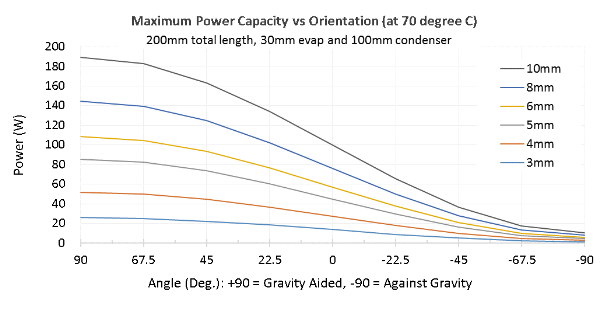
Heat Pipe Carrying Capacity (Qmax) by Orientation
When the heat pipe is required to operate in orientations between -50 to -90 degrees, the wick structure can be optimized to increase the capillary pumping action. As seen in the chart below, a gravity optimized 6mm heat pipe now has a higher power carrying capacity (Qmax) than its non-optimized 6mm counterpart, to meet the needs of this application. The trade-off? Its Qmax is lower than the non-gravity optimized 6mm pipe in orientations above -45 degrees.
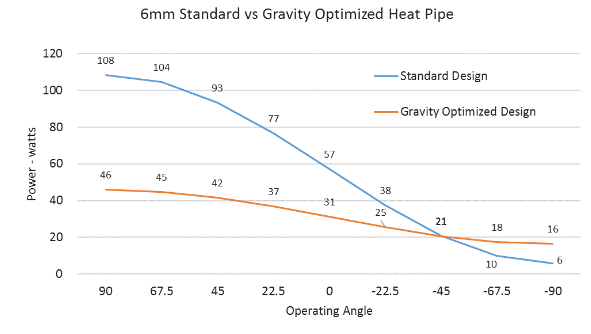
Gravity Optimized Heat Pipe
Heat Pipe Bending & Flattening
Heat pipes can be made into virtually any shape by bending and/or flattening them, subject to certain parameters. The typical minimum bend radius is 3-times the diameter of the tube. However, bending a heat pipe will reduce its Qmax, the maximum power transport capacity. Smooth, gradual bends will have less of an effect than tight ones, but a good rule of thumb is for every 45-degree bend Qmax will decrease by 2.5%.
Flattening a sintered heat pipe to one-third of its original diameter is generally considered the maximum, although this figure decreases with smaller pipes (2-4mm) and increases with larger ones (>10mm). Ultra-thin heat pipes can be produced using other wick structures. Performance can be affected as the tube is flattened. The chart below offers some insight into how flattening affects heat pipe performance. Provided a heat pipe is properly matched to the application, its Qmax is determined by the lower of the wick limit or the vapor limit. For instance, for a round 6mm standard heat pipe the wick limit (black dotted line) is just under 60 watts. Flattening it to 4, 3.5, or 3mm has no effect on its Qmax as the vapor limit is above the wick limit. Note that flattening a round 8 or 10mm heat pipe to 3mm or 2.5mm will have a substantial effect on its Qmax.
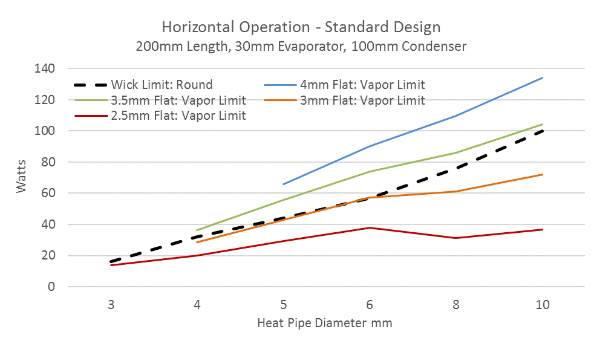
Maximum Heat Pipe Carrying Capacity is the Lesser of the Wick & Vapor Limits
Heat pipe technology offers advantages, including high thermal conductivity, ease of shape and bend, and long operational life, compared to other cooling mechanisms. Disadvantages include the higher cost of heat pipe devices, especially when compared to solid aluminum alternatives. Loop heat pipes, vapor chambers, and oscillating heat pipes are alternative types of two-phase devices used for cooling electronics and provide more design flexibility and higher power handling capacity in specific applications.
Heat pipes are particularly useful for improving heat sink performance in applications where heat needs to be moved or spread efficiently to the condenser area of the heat sink, such as in low or no airflow situations or when the heat sink is separated from the heat source. When designing heat pipes, engineers should carefully consider a range of factors, including the operating temperature range, power density, thermal budget, size constraints, and mechanical requirements.
Recommended Blog Posts
The Truth About Ultra-Thin Heat Pipe Vapor Chambers
Thin and ultra-thin heat pipe vapor chambers offer excellent choices for space-constrained applications where heat needs to be moved to a remote location or spread quickly to a larger heat sink surface area. However, mechanical engineers should be mindful of the...
Vapor Chamber vs Heat Pipe
Although based on the same inner working principles, heat pipes and vapor chambers have unique characteristics in terms of design, usage and integration.
How Do Heat Pipes Work | Heat Pipes 101
This article covers how heat pipes and vapor chambers work along with typical uses and configuration options. Further, it is designed to be a quick read with links to detailed information throughout the text. How Do Heat Pipes Work? There are three...
Heat Pipe Thermal Conductivity
Knowing heat pipe thermal conductivity is important when performing Excel or CFD modeling of two-phase devices integrated into a heat sink assembly. In theory, heat pipe thermal conductivity can range from 4,000 to 100,000 W/m-K. In reality, the range for electronics...

